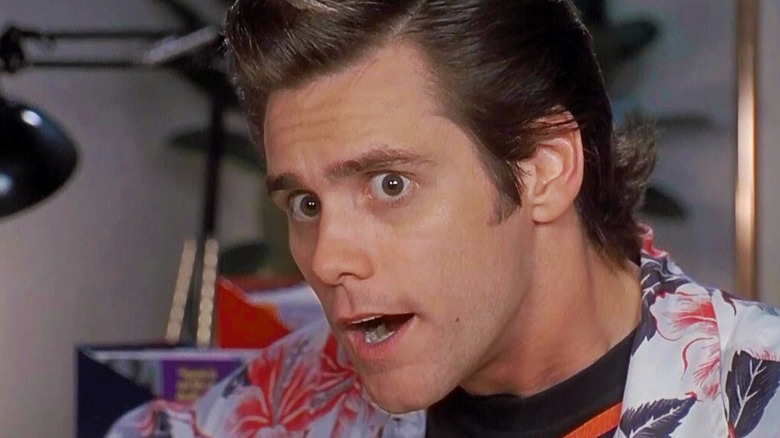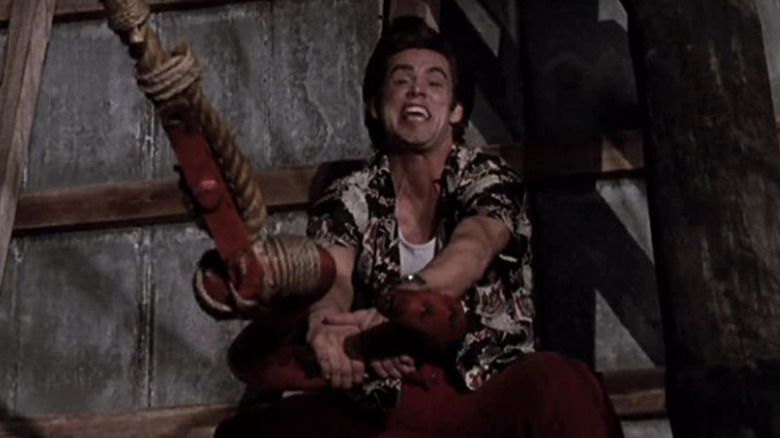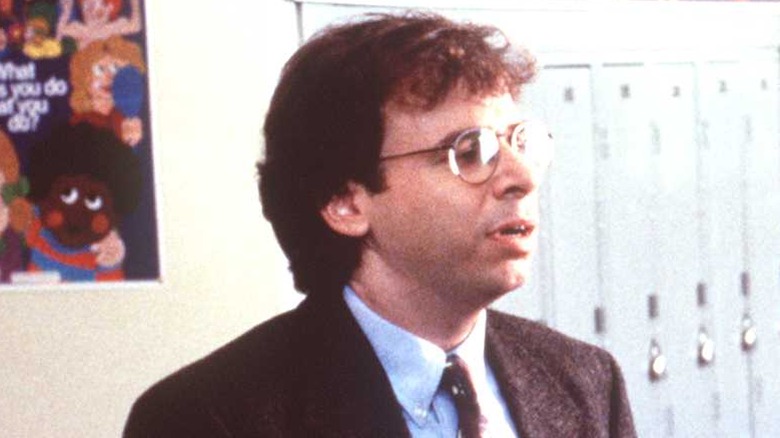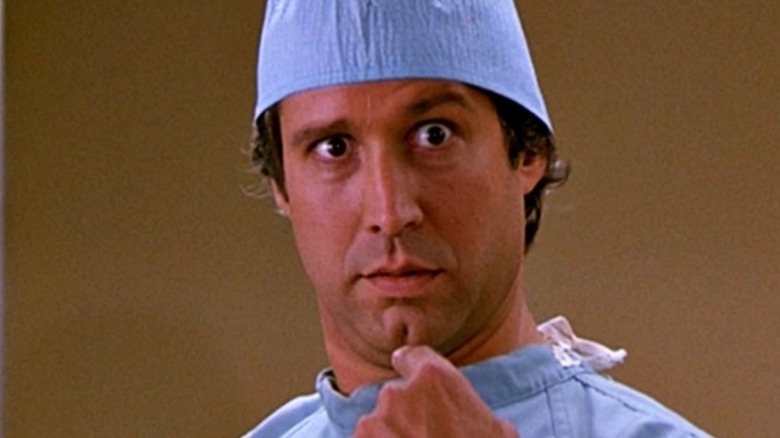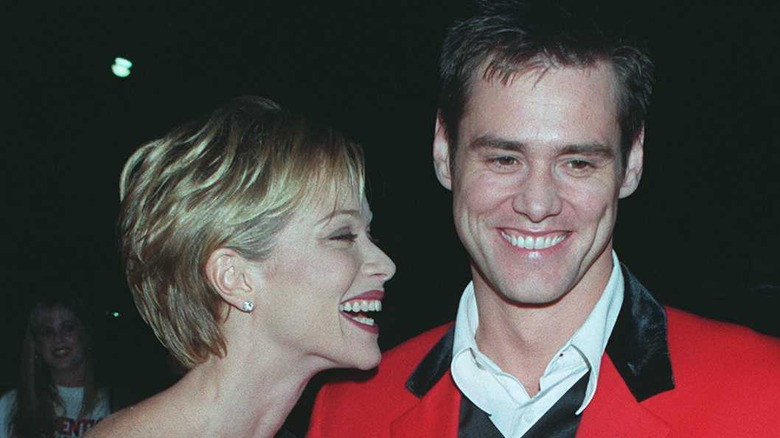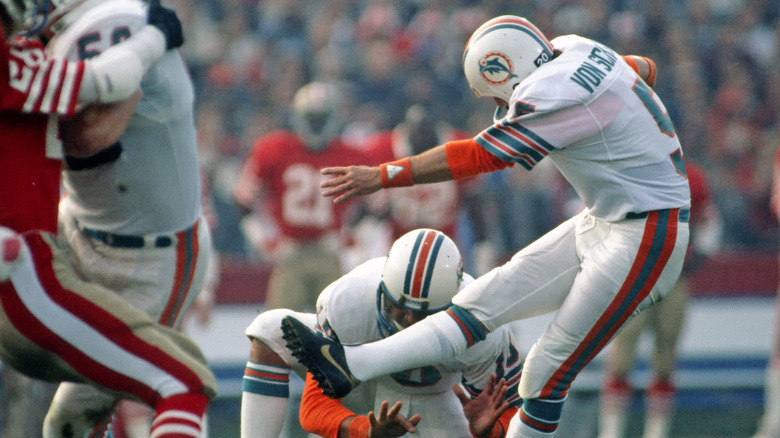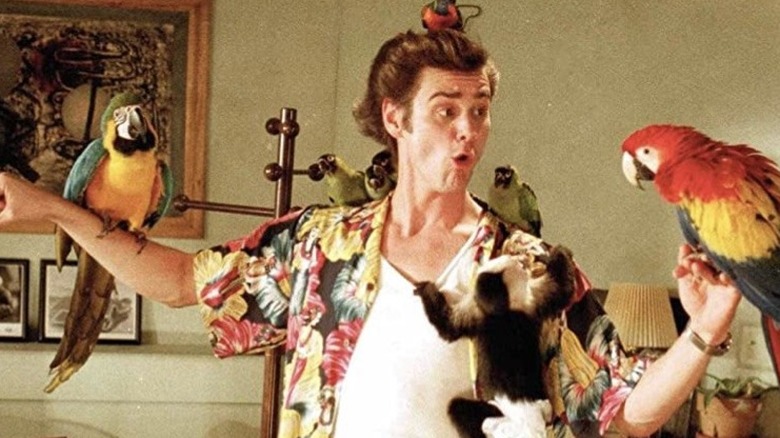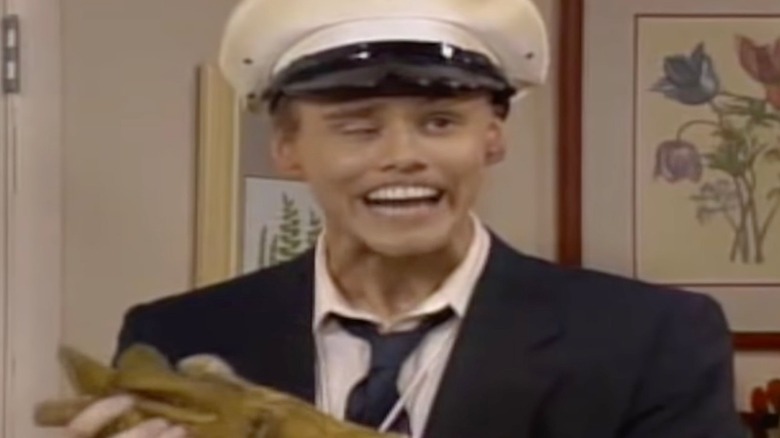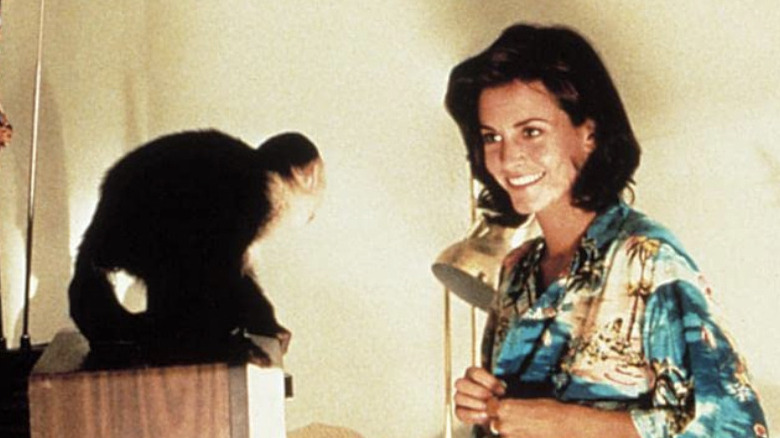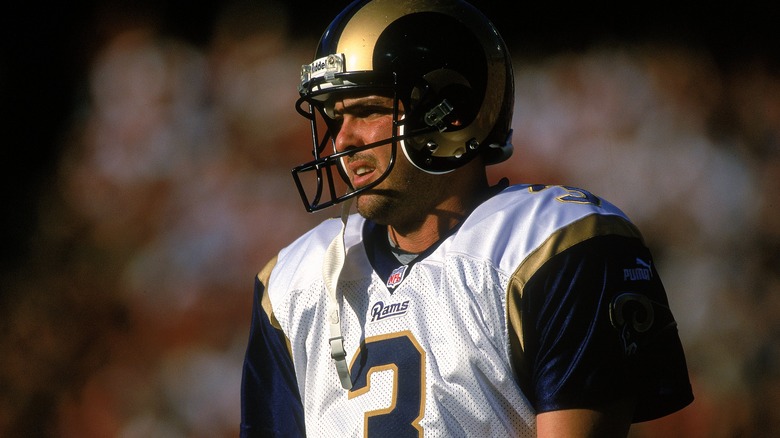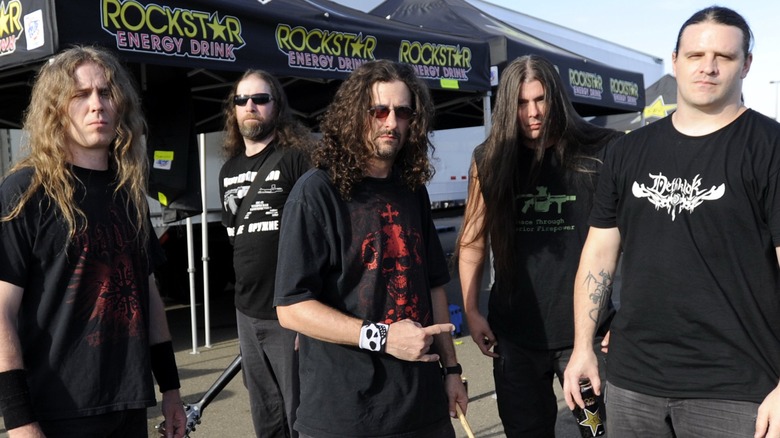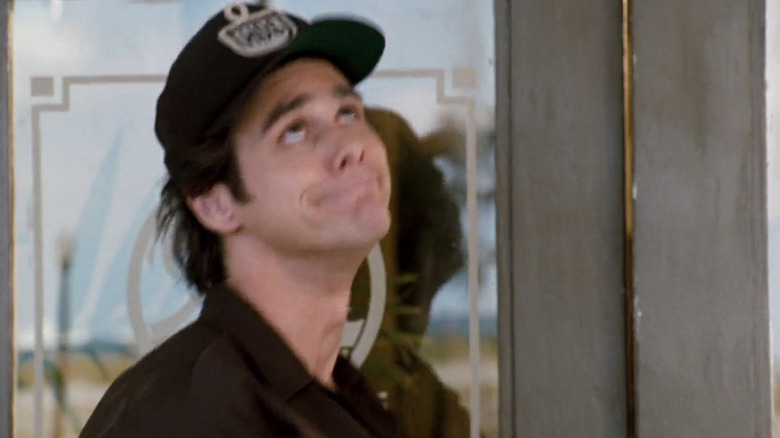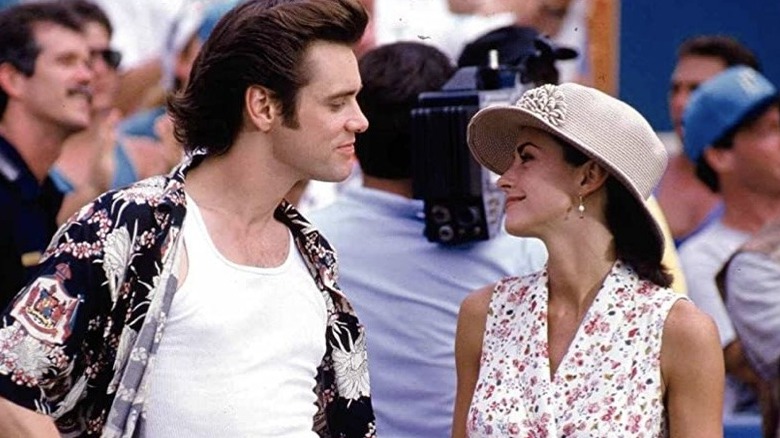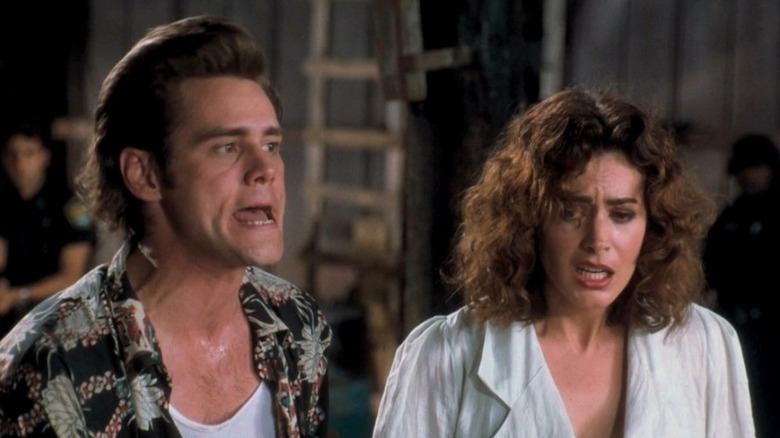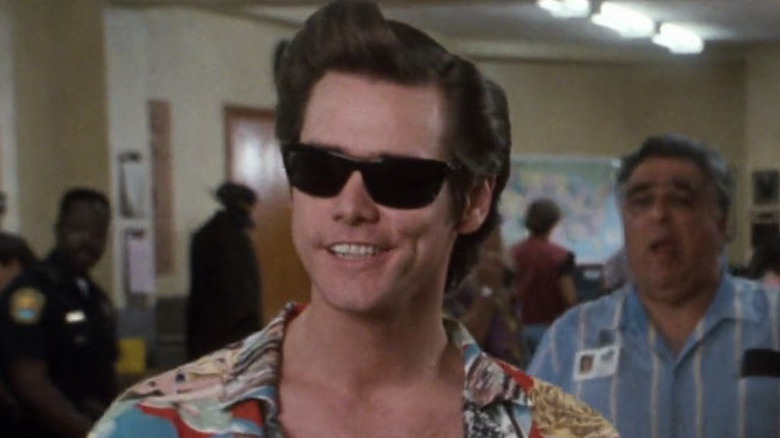The Untold Truth Of Ace Ventura
"Ace Ventura," though not Jim Carrey's film debut, was absolutely the film that put him on the map and made him a bankable movie star. Though it might be difficult now to overlook its transphobia enough to enjoy its comedy (per Quartz), "Ace Ventura" kicked off an incredible run of films for Carrey, eventually leading to him becoming the first actor to earn a $20 million paycheck for a single film (via CelebrityNetWorth), that film being 1996's "The Cable Guy." It even kicked off a mini-franchise, with its direct sequel "Ace Ventura: When Nature Calls" and the Carrey-less direct-to-DVD prequel, "Ace Ventura Jr."
The film itself has a simple plot about the titular pet detective on the hunt for a kidnapped dolphin, the mascot for the Miami Dolphins football team. From this unlikely setup, Carrey bends and contorts his rubbery features throughout, making the film a showcase for his mastery of physical comedy. From its initial draft to its massive box office haul, here is the untold truth of "Ace Ventura: Pet Detective."
The original script was much darker
Though not strictly a kid's film, there are plenty of goofy shenanigans in "Ace Ventura" to make it particularly popular with a younger crowd. However, as shown in the shooting script – credited to Jack Bernstein, Tom Shadyac, and Jim Carrey — and available for reading at Script Daily – there were some surprisingly dark gags that were either cut for the theatrical release or were never shot in the first place.
For example, in the climax there is a scene in which Ace knocks down two thugs with a steel hook on a chain. In the finished film they are simply knocked out, but the shooting script has this description: "Ace gently releases the hook. Just as Vinnie and Roc turn to look, the iron hook shears both of their heads clean off. Two headless bodies fall to the ground in slow motion with blood gushing from their necks." This is followed by Ace wondering if this technically counts as murder, since it was done in self defense.
Another scene is a dream sequence in which Ace is being pecked to death by pigeons, tearing his face apart and flying away with his body parts. Yet another gag has a suicidal gas station attendant with a shotgun in his mouth and his finger on the trigger, stopped only by a car pulling up for gas. Thankfully axed from the final film, one wonders how Ace would have been received had these pitch black gags made it into the theatrical cut.
Rick Moranis was the original choice for Ace
It's hard to imagine now, but Jim Carrey was not the initial choice to play his iconic role. According to Michael Kantor and Laurence Maslon's book "Make 'Em Laugh: The Funny Business of America," the role of Ace Ventura was originally offered to legendary comedian Rick Moranis, who turned it down. While Moranis definitely had the comedic chops to make the role his own, some of the other casting picks would have made for a much different film.
In Eila Mell's book "Casting Might-Have-Beens," after Moranis turned the film down producers considered casting Judd Nelson of "The Breakfast Club" fame, and, even more bizarrely, Alan Rickman. They even considered changing the gender of the character and casting Whoopi Goldberg as the lead. Eventually Carrey's work on "In Living Color" led producers to offer him the role, but one can only imagine what could have been if we had Hans Gruber bringing a decidedly more subtle performance to this goofy role.
The film was initially meant to be a newer version of Fletch
Though the film is famous for Carrey's over-the-top, rubber-faced performance, the initial concept was a much dryer affair. According to "Ace Ventura" director Tom Shadyac on the DVD commentary, earlier versions of the script were more like an update of "Fletch," the smug detective played by Chevy Chase in the 1985 film based on the Gregory Mcdonald novel. This idea carried over into the early days of filming, with Carrey performing his lines in a flat tone.
In fact, the voice for Ace didn't come until Shadyac went to one of Carrey's stand up comedy performances. He loved the way Carrey introduced himself to the audience, and the voice he used clicked in Shadyac's head as the perfect voice for Ace. From that moment on, he had Carrey perform the rest of the film using that voice, and a much looser, more slapstick take on the film ensued.
Lauren Holly was initially offered the role of Melissa
When Jim Carrey was cast as Ace Ventura, he definitely had a preference in mind for the role of his character's love interest, Melissa Robinson. Lauren Holly was mainly known for her work on the soap opera "All My Children," which she had joined in 1986. According to Eila Mell's book "Casting Might-Have-Beens," Carrey was an admirer of Holly's and pushed for her to be offered the role of Melissa. Holly auditioned and did well enough that she was offered the role. Strangely enough, though, she turned it down.
According to Entertainment Weekly, Holly later said of the decision, "I kicked myself when it came out." A second chance to work with Carrey came quickly that same year, when she was cast as Mary Swanson in "Dumb and Dumber." Not content to remain love interests on screen, the pair began dating that same year and eventually got married in 1996. Their marriage deteriorated rapidly, and the two filed for divorce the next year, citing irreconcilable differences (via E! Online).
The Ray Finkle plot was based on Scott Norwood from the Buffalo Bills
There isn't much in "Ace Ventura" that seems ripped from the headlines, but apparently the incident that sent Ray Finkle into a downward spiral — his "laces out" missed kick in the Super Bowl — was based on a real incident. The missed kick in the film was inspired by Scott Norwood, kicker for the Buffalo Bills who missed a kick in the 1991 Super Bowl. While Norwood was the inspiration for the plot, the likeness of Ray Finkle came from a much older player (per Enid News & Eagle).
Uwe Von Schamann, kicker for the Miami Dolphins from 1979-84, provided the likeness for Ray Finkle in the film, and footage from one of his games was used in the film itself. Von Schamann uses his notoriety from this film when going on speaking tours and apparently has no problem being forever connected to such a disturbed character.
Carrey based his performance on the movements of birds
Aside from the one-liners and physical gags, one of the most iconic aspects of Ace Ventura is how the character moves. His cocky strut, whipping his head back and forth, the jerky movements, all of it feels as animalistic as his non-human co-stars. According to Jim Carrey, this was intentional. In an interview with The New Yorker Festival, Carrey described Ace's signature walk as being "a smart bird at the edge of the pond." He then got up to strut around the stage, showing exactly how he translated these movements.
In addition to this interview, the bird inspiration was also mentioned in a section of his book, "Memoirs and Misinformation." Though the book is part autobiography and part fiction, the book contains an exchange between Carrey and Anthony Hopkins which The Hollywood Reporter confirmed actually took place. In this passage, Carrey describes his inspiration for Ace Ventura being "an intelligent bird; Hopkins's Hannibal Lecter was a hybrid crocodile-tarantula with infinite patience."
The talking butt scene came from Carrey's frustration with Keenan Ivory Wayans
Though he had been in major films before "Ace Ventura" — and even had a starring role in the teen sex comedy "Once Bitten" – in the early '90s Jim Carrey was most famous for being on Keenen Ivory Wayans' groundbreaking sketch comedy series "In Living Color." During his run on the show he developed popular characters like Fire Marshall Bill and Vera DeMilo, as well as celebrity impersonations of Jay Leno and Vanilla Ice. One of the four cast members to be in all five seasons of "In Living Color," Carrey was integral to the show's popularity and a fan favorite.
There was one particular instance which gave rise to a major disagreement with Wayans over a sketch that Carrey wanted to perform. According to Wayans in an oral history of "In Living Color" for Details.com, "We had a testy moment." It was during a meeting where, after Wayans told Carrey that a sketch he felt passionately about didn't work, Carrey stood up and "read[s] the entire skit from his a******." Wayans and Carrey, both livid, were ready to come to blows, but Wayans instead stormed out of the room. Eric Gold, manager for both Carrey and Wayans who was in the room at the time, commented, "So what happens? In 'Ace Ventura,' Jim speaks out of his a** and becomes a national sensation."
Courteney Cox was afraid of animals
As strange as it seems for someone cast in a film about a pet detective, co-star Courteney Cox was deathly afraid of animals. In a 1994 press kit interview, Cox admitted that she is "petrified of animals" and described her sex scene with Ace as "the worst scene [she] had in the movie." Between takes Cox would pull the covers over her head so she wouldn't have to see the 50-plus animals that were on the set, which included penguins, iguanas, monkeys and squirrels. She even states that if there were snakes in the scene that she probably would have quit. Though the animals were tied down, during takes some of the animals would get loose. In the same interview Cox mentions that one animal would occasionally attack another, which would cause the other animals to get riled up, and there would be a flurry of fur and feathers.
During one scene, she had to say a line to a small monkey sitting on a dresser. According to the interview, she said the line, "You like him, don't you?" but she was shaking so badly that the scene had to be cut. She further states that if she had to do a scene similar to the one where Carrey stands with his arms spread out and all the animals flock to him, that she would have set the script down and backed out of the film entirely.
Dolphins player Pete Stoyanovich stood in for Sean Young
Sean Young could never be mistaken for a football kicker, but her role in "Ace Ventura" did require a scene of her kicking a football through a hole in a building — something that proved challenging. According to the film's director commentary, this problem was remedied by bringing in someone with a bit more experience. Director Tom Shadyac said that Miami Dolphins' placekicker Pete Stoyanovich (later of the Kansas City Chiefs and the St. Louis Rams) was brought in to do the scene, and served as Young's kicking double. A surprising choice, but ultimately one that worked beautifully.
To achieve the illusion of Young kicking the ball they used a reverse shot with Stoyanovich as her body double. In nearly every take Stoyanovich was able to kick the ball through the hole in the warehouse. Thankfully audiences were none the wiser, and the scene as it is plays out moves smoothly from Young to Stoyanovich and back. As a nice reverse of this, according to the commentary, Young herself is in the Dolphins team picture as Ray Finkle, wearing a wig and mustache.
Cannibal Corpse appeared in the film specifically because Carrey was a huge fan
If there's one thing about "Ace Ventura" that's even more surprising than its plot twist, it's the unlikely cameo by notorious death metal legends Cannibal Corpse. A band known for extreme album art, grotesque lyrics, and song titles such as "A Skull Full of Maggots" and "Under the Rotted Flesh," their appearance in a PG-13 comedy seems completely out of left field. Clearly someone behind the scenes was a fan, and it turns out that it was none other than Carrey himself.
According to Cannibal Corpse drummer Paul Mazurkiewicz in an interview with Vice, their record label Metal Blade got the call from Carrey's people letting them know that he wanted them to be in the film. The band initially declined since they were on tour and had concerns about how the band was going to be portrayed.
Shockingly, according to Mazurkiwicz, they received another call a couple of days later. He recalls being told, "Jim Carrey really wants you guys. They're gonna rearrange their schedule to accommodate you." When they arrived on set, Carrey was so excited that he started singing lyrics to some of their songs and specifically requested that the band perform "Hammer Smashed Face" for the film. The respect was mutual — as Mazurkiwicz said, "It was so surreal — we were freaking out because we're on a movie set meeting Jim Carrey, and he's freaking out because he's meeting Cannibal Corpse."
Carrey came up with catchphrases and gestures in hopes that they would catch on
Before he became the pet detective, Carrey's most popular catchphrase — "Let me show you something!" — came from his "In Living Color" character Fire Marshall Bill. Given his years of work in sketch comedy, is should be no surprise that Carrey's performance in "Ace Ventura" was loaded with character quirks and catchphrases that caught on and became wildly popular.
As director Tom Shadyac notes in the director commentary, this was intentional on Carrey's part. He states that Carrey specifically crafted his trademark quips to be quotable for fans, even though not all of them ended up working out. While "alrighty then" and "loohoo, seher" became so popular that you might still hear them quoted today, the hand gesture that Ace makes when he leaves the police station never caught on beyond the film. This predilection of his likely inspired a lot of what he did later that year with his next hit film, "The Mask."
Courteney Cox developed a crush on Carrey during filming
Though Carrey may have had his sights set on future "Dumb and Dumber" co-star Lauren Holly, apparently during the filming of "Ace Ventura" his co-star Courteney Cox developed a crush on him. In an interview with Howard Stern, Cox admitted she had "a crush for sure" on Carrey. Cox describes in the interview that during rehearsals he played the role more subdued, keeping with the earlier "Fletch"-inspired take on the character, and that she thought, "Ooh, this is going to be a pet detective, hmm, and he's really playing it kind of straight."
When shooting began and he fully developed what we now know of as Ace Ventura, he brought all of his energy into his performance, and Cox said that she thought, "Oh my god, he's the funniest person." He kept her laughing during shooting of the film, and the two have remained friends to this day.
The Crying Game plot twist came near the end of shooting the film
By far the most controversial thing about "Ace Ventura" is the climactic plot twist, in which Detective Lois Einhorn, played by Sean Young, turns out to be the disgraced Miami Dolphins football kicker Ray Finkle. The film makes clear that this was inspired by the 1992 film "The Crying Game" and its gender twist, but what's most surprising about this is that "Ace Ventura" was already filming by the time "The Crying Game" was released to theaters.
According to Tom Shadyac in the director commentary, this was a last-minute decision that was made near the end of filming. As if the plot twist itself didn't make this clear, the Boy George song "The Crying Game" plays while Ace burns his clothes and showers in disgust. This late change to the plot probably explains why the twist comes across as so jarring in the film — it's hard to believe that Sean Young of all people could have been a beefy football kicker, but with all the other goings on in this film it just barely works.
Of course, as conversations about the representation of sexuality and gender have evolved, it's become increasingly clear to a mainstream audience just how much this transphobic and homophobic plot twist is in bad taste, to say the least. For his part, Carrey agrees. "In this day and age, it would probably not be done the same way," he told the Television Critics Association during a 2019 interview (via Showbiz CheatSheet). "There's a learning curve for all of us."
Ace Ventura was the first of three hit films for Carrey in one year
It's difficult to think of an actor who had a better breakout year than Jim Carrey did in 1994. In addition to finally becoming a legit movie star with "Ace Ventura," he followed that up five months later with the CGI-heavy comic book film "The Mask," and ended the year with the Farrelly Brothers debut film "Dumb and Dumber," where he met his future wife Lauren Holly. The combined gross of all three films is $706 million (per Showbiz CheatSheet), which is an astounding number for a comedian primarily known for a TV sketch show to make in his breakout year.
Ever the workaholic, even with three films in theaters during the same year Carrey was still a regular cast member on the final season of "In Living Color" that year. Though his then-wife Lauren Holly told Entertainment Weekly that Carrey was stuck in "sequel hell" after his debut year, with "Ace Ventura: When Nature Calls" and "Batman Forever" defining his 1995, Carrey moved on to bolder choices with dramatic roles in films such as "The Truman Show" and "Eternal Sunshine of the Spotless Mind."
